From the Trenches
Let Them Eat Soup
By DANIEL WEISS
Monday, October 15, 2018
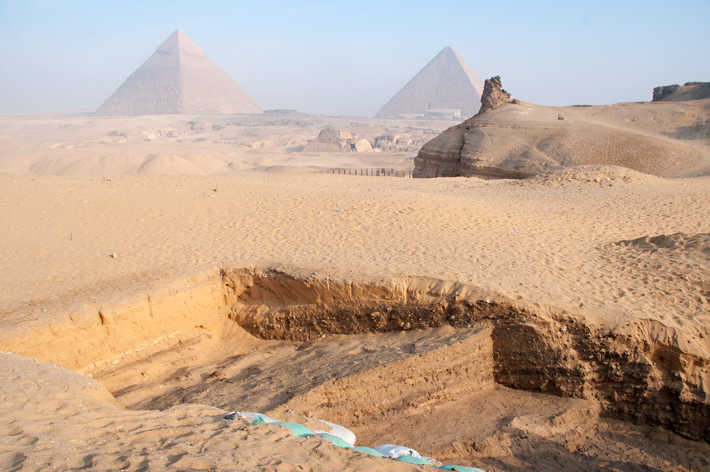 A large number of livestock bones found in a mound of settlement debris on Egypt’s Giza Plateau are offering possible insights into the diet of workers who toiled there some 4,500 years ago. Amid the debris, archaeologists from Ancient Egypt Research Associates (AERA) have unearthed sealings dating to the reign of the 4th Dynasty pharaoh Khafre (r. ca. 2520–2494 B.C.), along with chunks of painted plaster suggesting the material is from wealthy settlements.
A large number of livestock bones found in a mound of settlement debris on Egypt’s Giza Plateau are offering possible insights into the diet of workers who toiled there some 4,500 years ago. Amid the debris, archaeologists from Ancient Egypt Research Associates (AERA) have unearthed sealings dating to the reign of the 4th Dynasty pharaoh Khafre (r. ca. 2520–2494 B.C.), along with chunks of painted plaster suggesting the material is from wealthy settlements.
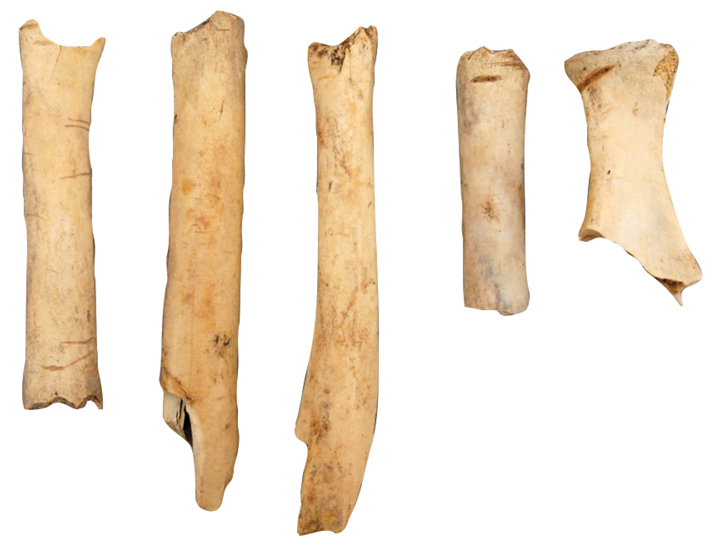 They also found a concentration of long, meat-bearing sheep and goat bones, many of whose ends had been snapped off. Two Egyptian archaeologists taking part in a field school at the site immediately recognized that the snapped-off ends were likely used to make gelatin soup, a cheap source of protein enjoyed to this day in Egypt. AERA director Mark Lehner suggests the meat from the bones was likely reserved for the area’s elites, while workers—quite possibly those who built Khafre’s pyramid, the second largest in Giza—were allotted the bone ends to make a protein-rich stew.
They also found a concentration of long, meat-bearing sheep and goat bones, many of whose ends had been snapped off. Two Egyptian archaeologists taking part in a field school at the site immediately recognized that the snapped-off ends were likely used to make gelatin soup, a cheap source of protein enjoyed to this day in Egypt. AERA director Mark Lehner suggests the meat from the bones was likely reserved for the area’s elites, while workers—quite possibly those who built Khafre’s pyramid, the second largest in Giza—were allotted the bone ends to make a protein-rich stew.
Beauty Endures
By JASON URBANUS
Monday, October 15, 2018
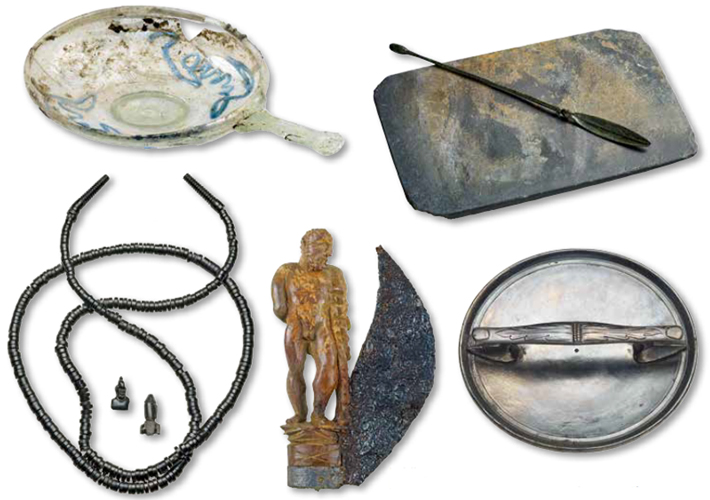 It was common in antiquity for deceased individuals to be sent on their journey to the afterlife with a collection of their cherished objects. Nevertheless, archaeologists in Germany were surprised by the burial assemblage of a wealthy Roman woman who was entombed with her jewelry, her makeup kit, and other finely crafted beauty items. “Cosmetic utensils and jewelry as gifts in women’s graves are not uncommon, but the variety and quality of the offerings is particularly interesting,” says Susanne Willer of the LVR-LandesMuseum in Bonn.
It was common in antiquity for deceased individuals to be sent on their journey to the afterlife with a collection of their cherished objects. Nevertheless, archaeologists in Germany were surprised by the burial assemblage of a wealthy Roman woman who was entombed with her jewelry, her makeup kit, and other finely crafted beauty items. “Cosmetic utensils and jewelry as gifts in women’s graves are not uncommon, but the variety and quality of the offerings is particularly interesting,” says Susanne Willer of the LVR-LandesMuseum in Bonn.
The discovery was made during the installation of sewer and drainage systems near Zülpich. The 25-to-30-year-old woman died around the fourth century A.D. and was interred in a massive stone sarcophagus. When researchers finally lifted and opened the 4.5-ton casket, they discovered a wealth of well-preserved cosmetic artifacts, including glass perfume vials, a bronze oil jar, a silver hand mirror, and a slate makeup palette, with application tools, hairpins, and even a finely carved folding knife with a Hercules figurine as its handle. One glass jar contained the Latin phrase Utere Felix, meaning “use (this) and be happy.” The unknown woman was buried along what would have been the main road connecting the important Roman towns of Trier and Cologne. “These burial offerings,” says Willer, “highlight the life of the rural upper classes in the Rhineland 1,700 years ago, their everyday culture, and their luxury.”
Iron Age Teenagers
By ERIC A. POWELL
Monday, October 15, 2018

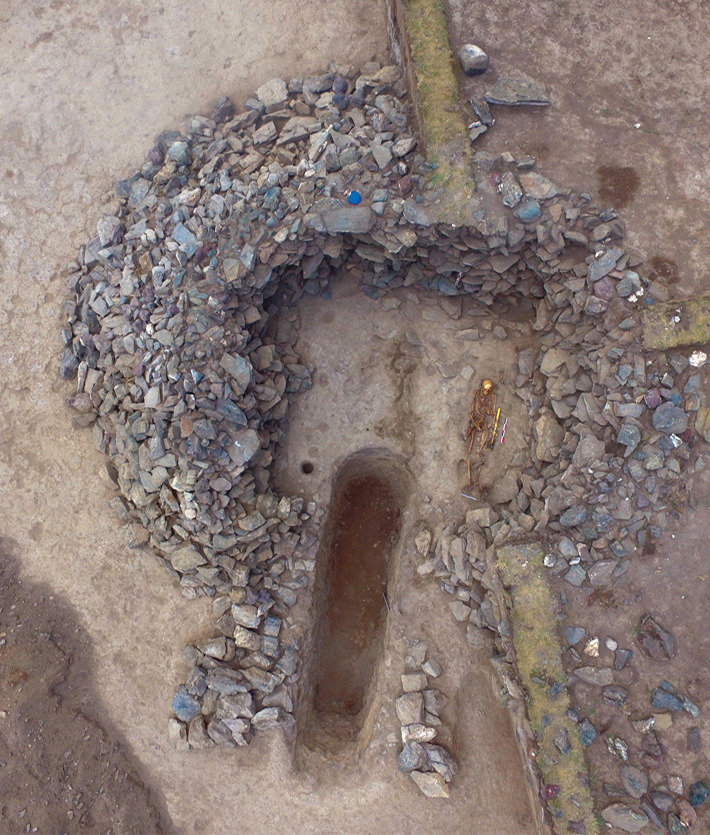 In a valley in eastern Kazakhstan’s remote Tarbagatai Mountains, archaeologists recently excavated a kurgan, or burial mound, holding the remains of two Iron Age teenagers who lived roughly 2,700 years ago. The two belonged to the Saka, a nomadic Iranian-speaking people closely related to the Scythians, who occupied much of Central Asia from the eighth to the second century B.C. Led by Zainolla Samashev, director of the Margulan Institute of Archaeology, the team identified the scant remains of a young woman of about 16 whose grave had been looted and the undisturbed skeleton of a man no older than 19. The man wore a golden torc around his neck, held a gold and bronze dagger, and was equipped with a gold-plated wooden quiver holding arrows with bronze tips. Both teenagers were buried in finery once covered with gold beads and gold appliqués of miniature deer heads with oversized antlers.
In a valley in eastern Kazakhstan’s remote Tarbagatai Mountains, archaeologists recently excavated a kurgan, or burial mound, holding the remains of two Iron Age teenagers who lived roughly 2,700 years ago. The two belonged to the Saka, a nomadic Iranian-speaking people closely related to the Scythians, who occupied much of Central Asia from the eighth to the second century B.C. Led by Zainolla Samashev, director of the Margulan Institute of Archaeology, the team identified the scant remains of a young woman of about 16 whose grave had been looted and the undisturbed skeleton of a man no older than 19. The man wore a golden torc around his neck, held a gold and bronze dagger, and was equipped with a gold-plated wooden quiver holding arrows with bronze tips. Both teenagers were buried in finery once covered with gold beads and gold appliqués of miniature deer heads with oversized antlers.

Hand of God
By JASON URBANUS
Monday, October 15, 2018
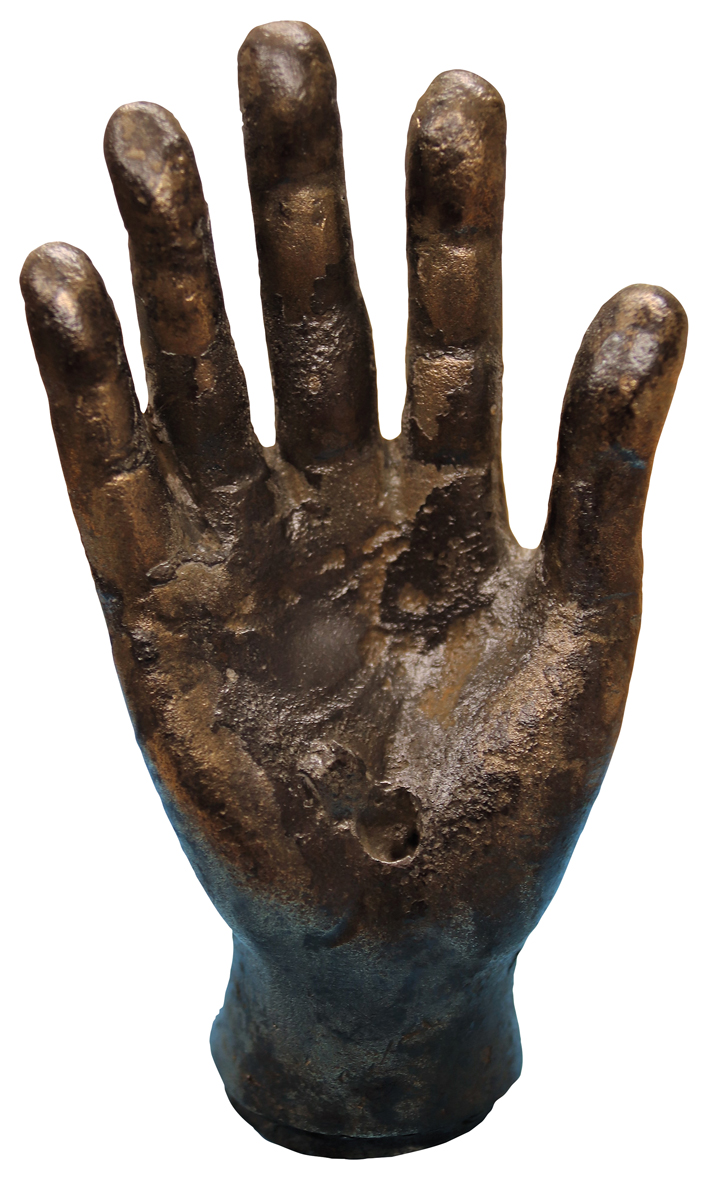 Archaeologists believe that a bronze hand from the Roman fort of Vindolanda was associated with the cult worship of Jupiter Dolichenus at the site. The palm of the four-inch hand may have once held a small effigy of the god, who was often depicted riding a bull and grasping an ax and a lightning bolt, says Vindolanda director of excavations, archaeologist Andrew Birley. The hand was originally attached to a staff that was likely used to bless worshippers. Although much is still unknown about the cult of Jupiter Dolichenus, it is believed that its origins lie in the Near East. “What little we do know is that the cult was open to both men and women, and to different social strata in Roman society, which would make it appealing to a broad audience,” says Birley. Both the hand and the temple of Jupiter Dolichenus in Vindolanda date to the early third century A.D., a tumultuous period in Roman Britain, fraught with war, rebellion, and bloodshed.
Archaeologists believe that a bronze hand from the Roman fort of Vindolanda was associated with the cult worship of Jupiter Dolichenus at the site. The palm of the four-inch hand may have once held a small effigy of the god, who was often depicted riding a bull and grasping an ax and a lightning bolt, says Vindolanda director of excavations, archaeologist Andrew Birley. The hand was originally attached to a staff that was likely used to bless worshippers. Although much is still unknown about the cult of Jupiter Dolichenus, it is believed that its origins lie in the Near East. “What little we do know is that the cult was open to both men and women, and to different social strata in Roman society, which would make it appealing to a broad audience,” says Birley. Both the hand and the temple of Jupiter Dolichenus in Vindolanda date to the early third century A.D., a tumultuous period in Roman Britain, fraught with war, rebellion, and bloodshed.
Aztec Fishing
Monday, October 15, 2018
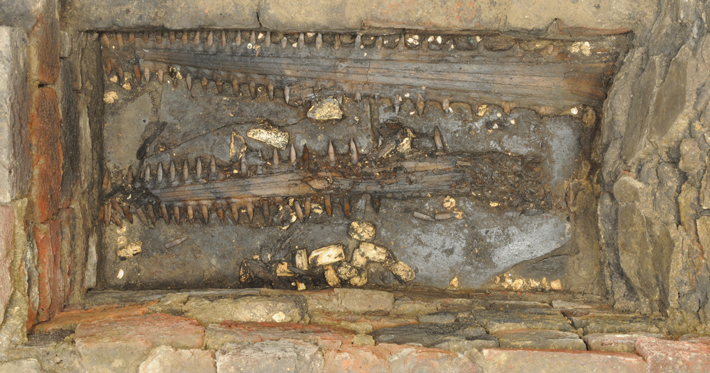 Mexican archaeologists have discovered a 39-inch-long sawfish blade at the bottom of a stone box packed with thousands of other ceremonial objects at the Aztec religious complex in Mexico City known as the Templo Mayor. This isn’t the first sawfish blade excavated there—archaeologists have found 77 so far—but it is possibly the largest, says the project’s director, Leonardo López Luján. Sawfish, a type of ray, had deep spiritual significance for the Aztecs because the fish was considered a hybrid of earth and sea, says archaeologist Alejandra Aguirre. The blade, its sharp teeth intact, was the last object to be excavated from a deposit containing some 11,800 artifacts, including the carcass of a wolf dressed in gold armor (“Aztec Warrior Wolf,” Top 10, January/February 2018), birds, and thousands of snails. Known as Offering 174, the box was interred under a floor during the reign of the emperor Ahuitzotl (1486–1502) and, according to Aguirre, may be a kind of tribute to the expansion of the Aztec realm under his rule.
Mexican archaeologists have discovered a 39-inch-long sawfish blade at the bottom of a stone box packed with thousands of other ceremonial objects at the Aztec religious complex in Mexico City known as the Templo Mayor. This isn’t the first sawfish blade excavated there—archaeologists have found 77 so far—but it is possibly the largest, says the project’s director, Leonardo López Luján. Sawfish, a type of ray, had deep spiritual significance for the Aztecs because the fish was considered a hybrid of earth and sea, says archaeologist Alejandra Aguirre. The blade, its sharp teeth intact, was the last object to be excavated from a deposit containing some 11,800 artifacts, including the carcass of a wolf dressed in gold armor (“Aztec Warrior Wolf,” Top 10, January/February 2018), birds, and thousands of snails. Known as Offering 174, the box was interred under a floor during the reign of the emperor Ahuitzotl (1486–1502) and, according to Aguirre, may be a kind of tribute to the expansion of the Aztec realm under his rule.
Advertisement
Advertisement
IN THIS ISSUE
From the Trenches
The American Canine Family Tree
Off the Grid
Mars Explored
Aztec Fishing
Iron Age Teenagers
Hand of God
Beauty Endures
Let Them Eat Soup
Another Form of Slavery
Eat More Spore
Well, Well
Nomadic Necropolis
Conan's Storm Cellar
World Roundup
Aztec rain temple, Ötzi’s last meal, Roman whalers, and Germany’s oldest public library
Artifact
A draft of comfort
Advertisement

Recent Issues
-
 May/June 2024
May/June 2024
-
 March/April 2024
March/April 2024
-
 January/February 2024
January/February 2024
-
 November/December 2023
November/December 2023
-
 September/October 2023
September/October 2023
-
 July/August 2023
July/August 2023
-
 May/June 2023
May/June 2023
-
 March/April 2023
March/April 2023
-
 January/February 2023
January/February 2023
-
 November/December 2022
November/December 2022
-
 September/October 2022
September/October 2022
-
 July/August 2022
July/August 2022
-
 May/June 2022
May/June 2022
-
 March/April 2022
March/April 2022
-
 January/February 2022
January/February 2022
-
 November/December 2021
November/December 2021
-
 September/October 2021
September/October 2021
-
 July/August 2021
July/August 2021
-
 May/June 2021
May/June 2021
-
 March/April 2021
March/April 2021
-
 January/February 2021
January/February 2021
-
 November/December 2020
November/December 2020
-
 September/October 2020
September/October 2020
-
 July/August 2020
July/August 2020
-
 May/June 2020
May/June 2020
-
 March/April 2020
March/April 2020
-
 January/February 2020
January/February 2020
-
 November/December 2019
November/December 2019
-
 September/October 2019
September/October 2019
-
 July/August 2019
July/August 2019
-
 May/June 2019
May/June 2019
-
 March/April 2019
March/April 2019
-
 January/February 2019
January/February 2019
-
 November/December 2018
November/December 2018
-
 September/October 2018
September/October 2018
-
 July/August 2018
July/August 2018
-
 May/June 2018
May/June 2018
-
 March/April 2018
March/April 2018
-
 January/February 2018
January/February 2018
-
 November/December 2017
November/December 2017
-
 September/October 2017
September/October 2017
-
 July/August 2017
July/August 2017
-
 May/June 2017
May/June 2017
-
 March/April 2017
March/April 2017
-
 January/February 2017
January/February 2017
-
 November/December 2016
November/December 2016
-
 September/October 2016
September/October 2016
-
 July/August 2016
July/August 2016
-
 May/June 2016
May/June 2016
-
 March/April 2016
March/April 2016
-
 January/February 2016
January/February 2016
-
 November/December 2015
November/December 2015
-
 September/October 2015
September/October 2015
-
 July/August 2015
July/August 2015
-
 May/June 2015
May/June 2015
-
 March/April 2015
March/April 2015
-
 January/February 2015
January/February 2015
-
 November/December 2014
November/December 2014
-
 September/October 2014
September/October 2014
-
 July/August 2014
July/August 2014
-
 May/June 2014
May/June 2014
-
 March/April 2014
March/April 2014
-
 January/February 2014
January/February 2014
-
 November/December 2013
November/December 2013
-
 September/October 2013
September/October 2013
-
 July/August 2013
July/August 2013
-
 May/June 2013
May/June 2013
-
 March/April 2013
March/April 2013
-
 January/February 2013
January/February 2013
-
 November/December 2012
November/December 2012
-
 September/October 2012
September/October 2012
-
 July/August 2012
July/August 2012
-
 May/June 2012
May/June 2012
-
 March/April 2012
March/April 2012
-
 January/February 2012
January/February 2012
-
 November/December 2011
November/December 2011
-
 September/October 2011
September/October 2011
-
 July/August 2011
July/August 2011
-
 May/June 2011
May/June 2011
-
 March/April 2011
March/April 2011
-
 January/February 2011
January/February 2011
Advertisement






